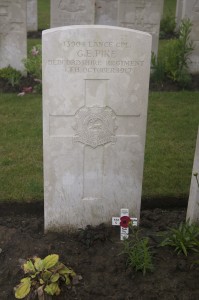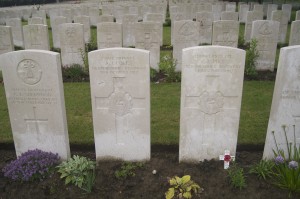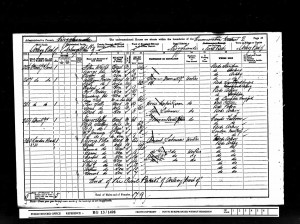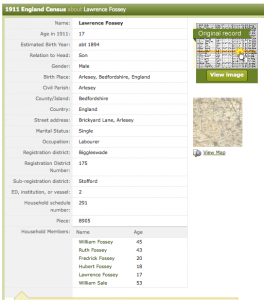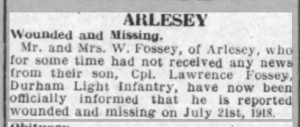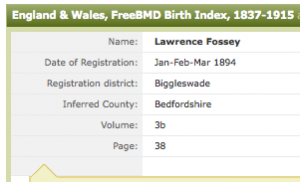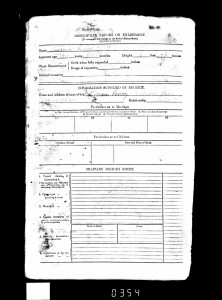George Edward Pike
Name: George Edward Pike
1888 - 4th October 1917
Place of Birth: Arlesey
Occupation: Labourer
Division: 1st Battalion
Regiment: Bedfordshire Regiment
Rank: Lance Corporal
Buried: XVII. C. 11, Hooge Crater Cemetery, Ieper, West-Vlaanderen, Belgium
Person(s) placing the cross on behalf of the Arlesey Remembers You Project: Clive Middleditch
George was born in Arlesey in 1888, the son of George and Sarah Pike. The Pike family was quite large, consisting of George, a cement yard labourer, Sarah; daughters, Isabel (born 1876) and Emma (born 1881), and sons Harry (born 1878), Herbert (born 1883), Ernest (born 1886), George and Frederick (born 1890). In the 1891 census the family were listed as living in the High Street, Arlesey.
In the 1901 census the family were living at 30 London Road, Arlesey and George Jr was now working as brickyard labourer.
On the 10th July 1905, George was attested into the Bedfordshire Regiment for a period of 6 years. The information on his service records tell us he was living at 30 New Road, Arlesey and was employed by Mr Newbury as a labourer in Hitchin. He was 17 years and 10 months old and single. His physical description was given as 5 feet 6.5 inches tall, fresh complexion, brown eyes and dark hair. George was discharged by purchase on 16th February 1906. Soldiers were entitled to be discharged by purchase (of 10/-) within three months of attestation if they were between 17 and 18 years of age at the date of application for discharge.
In July 1908 George was attested into the West Riding Regiment, at the age of 20 years and 10 months. His next of kin were his parents, George and Sarah, who were living in Seymour Road, Arlesey and his brothers. He was discharged on 5th September 1908 when a payment of £10 had been received within 3 months of his attestation. The West Riding Regiment received a reference for George from Messrs J Rotherham & Co. George had worked for them as a warehouse porter for 5 months from February 7th 1908 to July 11th 1909, when he left to join the army. They in turn had received a reference from Arlesey Cement Works, where George had been employed for the previous 4 – 5 years.
After leaving the army for a second time George appears to have stayed in Yorkshire - the 1911 census tells us George was boarding with the Jackson family in Howden Dyke, Kilpin, Yorkshire and was working as a chemical labourer. George then moved back to the Arlesey area and in 1912 he married Elizabeth L Howard and they had one child. George was employed at Ball’s Builders in Letchworth.
When the war broke out George enlisted in Letchworth, for the Bedfordshire regiment in early September 1914, and joined the 1st Battalion.
In 1915 George was part of the British Expeditionary Force in France. In October his parents were informed that he had been severely wounded in the arm and leg. George returned to the front and was injured again in May 1917 when he was blown up by shrapnel and wounded in the leg.
The war diary shows the Operation Orders for the 1st Battalion for October 1st and 2nd 1917 describing the battalions’ movement towards Hazebrouck and preparing for action as par of the Third Battle of Ypres. Records of the battle show that on the date of George’s death the British Army were engaged in the Battle for Broodseinde. This Battle was the most successful Allied attack as part of the Battle of Passchendaele. Heavy rain began on October 4th and affected the remainder of the campaign, working to the advantage of the German defenders. The British had to move their artillery forward into the area devastated by shellfire and soaked by the return of heavy rain, restricting the routes on which guns and ammunition could be moved, which presented German artillery with easier targets.
George was killed instantly on 4th October 1917, when a shell burst in his trench, killing four men in one hit. Pte W Kitely, an Arlesey soldier in France with George, wrote to his parents to inform them that George had been killed; “with sad regret I have to inform you of the death of George, who was killed in action on Oct 4th. It is hard luck for you all, and I hope his wife will take it as well as can be expected. He was killed by a shell bursting in the trenches. He and a sergeant from Baldock are buried side by side. It’s been the worst I have been in. I was not right up with the battalion; he seemed about the same when I saw him just as he was going up. I went up with the ambulance the next day, it came hard with me, just back from leave, and I can tell you we have had a week of the worst, although a big victory. Harry Bland has also been killed in this last battle, so there is another family that will feel the pinch of this war, this is the hardest shock I have had, to know what one more of my Arlesey chums were gone”.
Four of George’s brothers also served King and Country during the war. Pte Frederick Pike was in the South West Welsh Border Regiment; Private Harry Pike was in the Bedfordshire Regiment as was Pte Alfred Pike. The other brother, Pte Ernest Pike of the Bedfordshire Regiment, was killed in action in France on March 19th 1915.
George is remembered with honour at the Hooge Crater Cemetery in West-Vlaanderen, Belgium. The crater was made by a mine sprung by the 3rd division in July 1915. The cemetery was begun by the 7th division burial officer early in October 1917. There are 5,916 Commonwealth servicemen of the First World War buried or commemorated in the cemetery. 3,570 of the burials are unidentified, but special memorials record the names of a number of casualties either known or believed to be buried among them.


